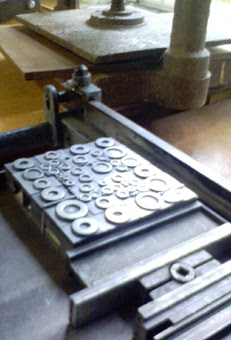
A new reader in Spain voted for a post about The Book as Art. And since she has one of the most delightful bibliophiliac websites I've seen in a while: Imatges i Paraules (where my lack of Spanish literacy is no impediment to enjoying her wonderful images of books, readers, libraries, artist's books etc) I can only oblige.
Judging The Book as Art by its cover will not lead you astray. It's a beautifully designed and case bound hardback of a manageable coffee table size i.e. possible to hold comfortably for reading in bed, not just leaning over the coffee table. The red cloth with gold embossed lettering is enlivened with a photograph of one of the most intriguing artist's book featured inside the covers.
This is not a 'how-to' book but a museum catalogue highlighting books held in the collection of the National Museum of Women in the Arts. Each featured book is illustrated by one beautiful photograph (occasionally two) and a short statement by the artist. This is the book's only shortcoming: very few artist's books are so simple as to be satisfactorily illustrated with a single still photograph. This limitation is theoretically somewhat overcome on the National Museum of Women in the Art's website where, if you have broadband, you can use a page turning tool for view multiple views of each book. My laptop took hours to open each high resolution photograph* so I returned instead to the hard-copy book.
The range of books provides a good overview to the broadest definition of what constitutes a book... from lavishly illustrated conventional codex structures to fanciful sculptures; from all text to all image; with pop-ups, prints, silhouettes, paint and assemblage; from comedy to tragedy and from sublime to mundane; there are books to delight, challenge, comfort and pique.
I found many of the artist's statements worth studying as closely as the photograph of their work. The statements make me wonder if perhaps book artists tend to be more articulate in writing about their work than many other artists who might have developed their visual language skills at the expense of fluent writing. I don't know, but anyway, this is as much an art book for reading as for looking at the pictures. And the three essays (by the curator and two famous book artists) that introduce the catalogue both continue the theoretical conversations that I follow on Bookarts-List and share personal stories of lives immersed in the book arts.
Rich and stimulating fare. I've borrowed The Book as Art from the ABC library but I think I would like to have a copy of my own, if anyone was starting to wonder what to give me for my birthday in 2 months time.
*which is why the picture is from Imatges i paraules not NMWA




